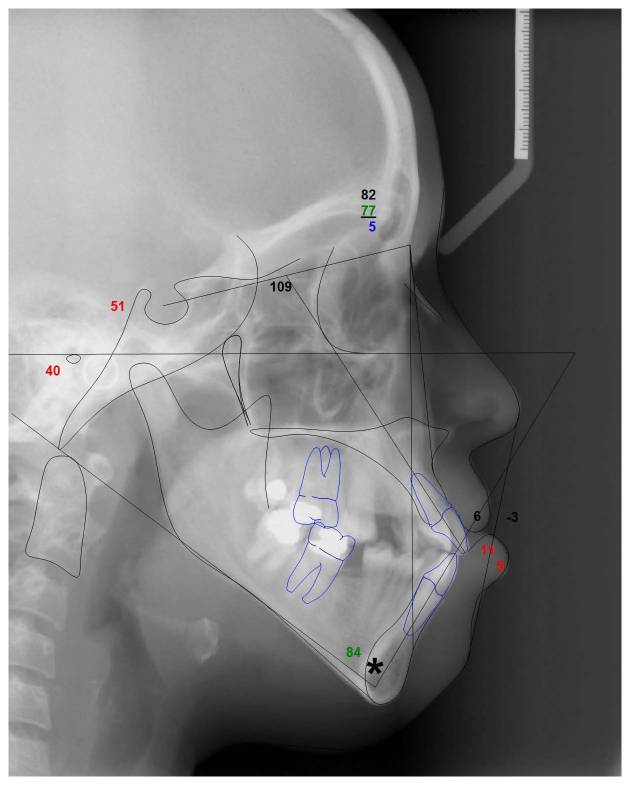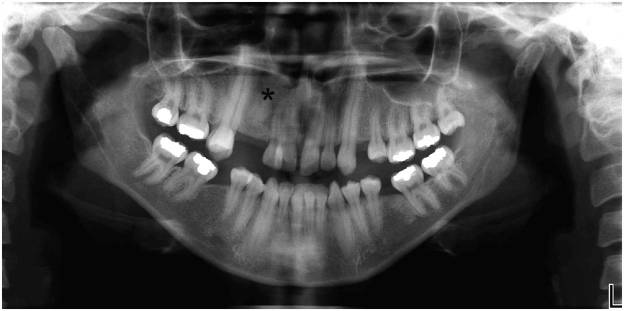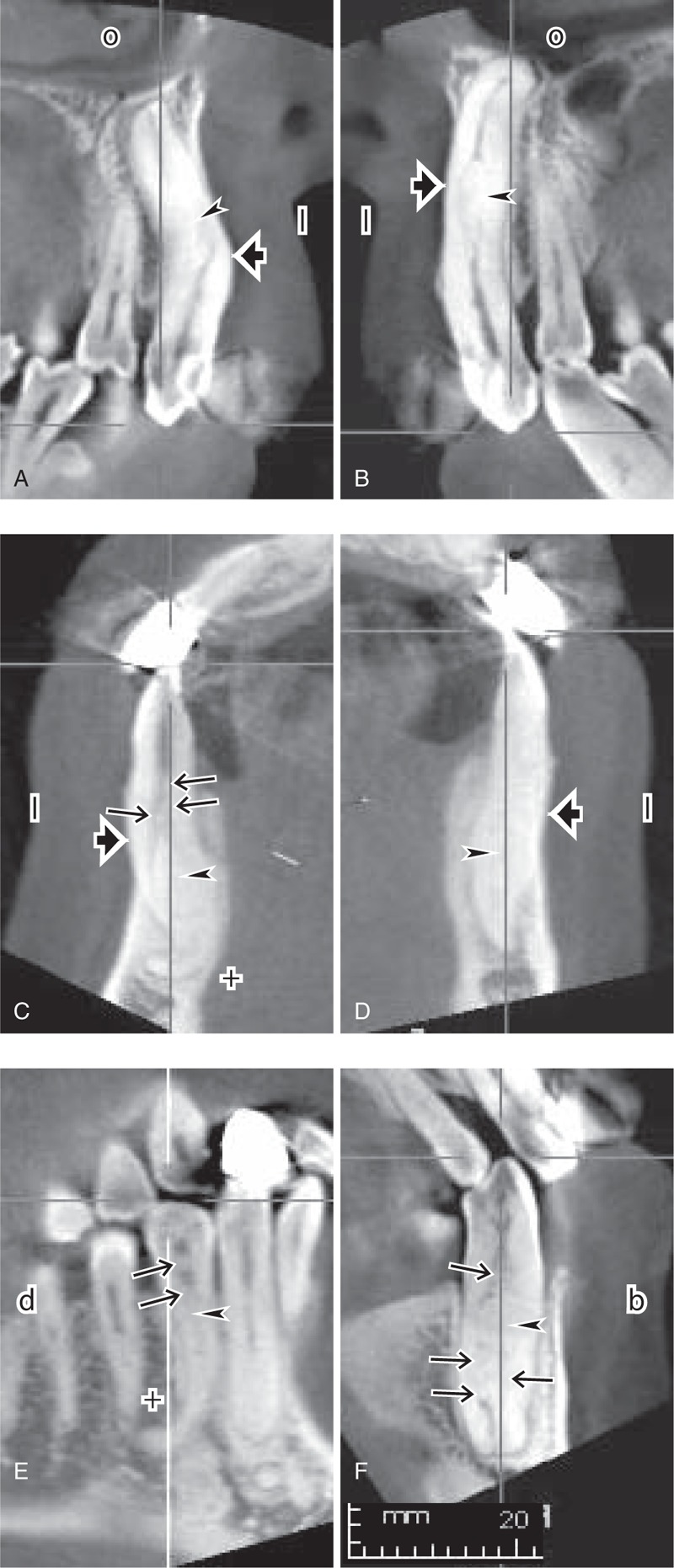Oculofaciocardiodental syndrome
| Oculofaciocardiodental syndrome |
Editor-In-Chief: C. Michael Gibson, M.S., M.D. [1]; Associate Editor(s)-in-Chief: Seyed Arash Javadmoosavi, MD[2]
Synonyms and related keywords: MCOPS2 or Microphthalmia, cataracts, radiculomegaly, and septal heart defects or Microphthalmia, syndromic 2, Oculo-facio-cardio-dental syndrome, OFCD syndrome
Overview
Oculofaciocardiodental syndrome (OFCD) is a rare congenital condition affecting eyes, heart, face and teeth. This syndrome is a X-linked syndrome and it has been seen in heterozygous female only. Due to its lethal affects on male, there has been no report of affected male. Common signs and symptoms include cataract, small deep-set eyes, long narrow face, heart defects and teeth with large roots.
Historical Perspective
- OFCD initially was described by Hayward, an oral surgeon, in 1980 as ocular, facial, cardiac and dental abnormalities.[1]
- In 1999, Schulze BR discovered that this syndrome has lethal effects on affected males and it has been seen in only heterozygous females.
- Further investigations by Hayward and Schulze indicated that OFCD has ocular problems like congenital cataract, microphthalmia as well as cardiac symptoms like atrial septal defect, ventricular septal defect and mitral valve prolapse.
- Its dental abnormalities including delayed tooth eruption and prolonged retention of primary teeth were described in 1990 by Marashi and Gorlin.
Classification
- There is no established system for classification of OFCD.
Pathophysiology
- The genetic analysis in oculofaciocardiodental syndrome patients shows mutations in BCOR gene on chromosome Xp11.4 which has functions like maintaining tissue homeostasis and gene silencing by epigenetic mechanisms.[2]
- BCOR gene provides instructions for making BCL6 corepressor protein. The BCL6 corepressor plays an essential role in early embryonic development, including the formation of the eyes and several other tissues and organs like the cardiovascular system and face tissues.
- It can also involve in specifying the left and right sides of the body in the developing embryo.
Causes
- OFCD syndrome may be caused by mutation in BCOR gene on chromosome Xp11.4
Differentiating OFCD from other diseases
- It is important to differentiate between OFCD syndrome and marfan syndrome. Patients with marfan syndrome present OFCD symptoms plus musculoskeletal, CNS, pulmonary and integumentary manifestation.[3]
- It can be misdiagnosed as congenital rubella due to association of congenital cataract with cardiac anomalies.
Epidemiology and Demographics
- Oculofaciocardiodental syndrome is very rare; the incidence is estimated to be less than per million people.[4]
- It is primarily only found in females while it is highly rare in males.
Risk Factors
There are no established risk factors for OFCD syndrome.
Screening
There is insufficient evidence to recommend routine screening for OFCD syndrome.
Natural History, Complications, and Prognosis
- Girls with this condition are born with eyeballs that are abnormally small microphthalmia. Other eye problems can include cataract and a higher risk of glaucoma.[5]
- If left untreated, patients with OFCD syndrome may progress to develop cardiac failure and blindness.[6]
- Cardiac complications may include:[1]
- Other complications include:
- Prognosis is generally poor in males.
Diagnosis
Diagnostic Study of Choice
Diagnosis of oculofaciocardiodental syndrome is based on genetic analysis and clinical characteristics.
History and Symptoms
The majority of patients with [disease name] are asymptomatic. OR The hallmark of [disease name] is [finding]. A positive history of [finding 1] and [finding 2] is suggestive of [disease name]. The most common symptoms of [disease name] include [symptom 1], [symptom 2], and [symptom 3]. Common symptoms of [disease] include [symptom 1], [symptom 2], and [symptom 3]. Less common symptoms of [disease name] include [symptom 1], [symptom 2], and [symptom 3].
Physical Examination
- Physical examination of patients with Oculofaciocardiodental syndrome is usually remarkable for characteristic facial features, missing or abnormally small teeth, misaligned teeth, and defective tooth enamel, and a heart murmur.
- Facial manifestations include a long, narrow face with distinctive facial features, including deep-set eyes and a broad nasal tip that is divided by a cleft.
Facial Abnormalities
- Long narrow face[7]
- High nasal bridge
- Broad nasal tip with separated nasal cartilages
- Laterally curved and thick eyebrows
- Long philtrum
- Clefts of the hard / soft palate

Ocular Abnormalities
- Microphthalmia
- Abnormal red reflex due to cataract
- Ptosis
- Exotropia
- High intraocular pressure due to glaucoma
- Others physical examination findings include:[4]
- hammer-type flexion of toes 2 and 3
- clinodactyly of toes 4 and 5
Laboratory findings
- There are no diagnostic laboratory findings associated with OFCD
Electrocardiogram
- In patients with OFCD, ECG is usually normal.
X-ray
Dental Abnormalities
The specific dental findings (visible on a panoramic radiograph of the jaws) can be easily diagnosed by an orthodontist or a dentist.[1]
- Radiculomegaly: The most consistent and pathognomic dental finding of oculofaciocardiodental syndrome is radiculomegaly (extremely long roots), particularly of the canines and occasionally of other teeth including premolars and incisors.
- Slow and delayed dental eruption: The dental eruption in both the deciduous and the permanent dentition is consistently slow and delayed.
- Oligodontia
- Fused teeth
- Supernumerary teeth
- Malformed permanent teeth
- Enamel defects
- Root dilacerations
- Malposition
- Malocclusion


- Intraoral radiographs in most pf the patients show abnormal dental root maturation with pulp stone-like calcification (PSLC) in teeth pulp and calcified dental papilla (CDP) beneath dental roots.[8]
- Cephalometric radiograph in some patients reveals elongated lower facial height and steep mandibular plane angle.[1]. Also abdominal X-ray may show cardiomegaly or pulmonary oedema andplueral effusion in severe cases.
Echocardiography
- Echocardiography may be helpful in detection and following up of cardiovascular manifestation of OFCD.
- Echocardiographic findings of OFCD include:
CT scan
- Dental Cone Beam CT (CBCT) can be performed in some patients and confirms round-calcified-tissue and PSLC which are associated with radiculomegaly.

CT scan[8]
MRI
- There are a few MRI findings associated with OFCD, though in some cases brain MRI has shown extracranial hemangioma on the frontal scalp.[9]
Other Imaging Findings
- There are no other imaging findings associated with OFCD syndrome
Other Diagnostic Studies
There are no other diagnostic studies associated with OFCD syndrome
Treatment
- The OFCD management includes surgical interventions.
Surgery
- Surgery is the mainstay of treatment for OFCD which includes orthodontic treatment for dental manifestation and orthognathic surgery to solve skeletal anomalies, and cataract surgery.
- Orthodontic and orthognathic surgery include:[3]
- Lower fixed appliance
- Upper fixed appliance
- Maxillary impaction
- Bilateral sagittal split osteotomy
- Genioplasty
Primary Prevenytion
- There are no established measures for the primary prevention of OFCD syndrome.
Secondary Prevention
- There are no established measures for the secondary prevention of OFCD syndrome.
References
- ↑ 1.0 1.1 1.2 1.3 1.4 1.5 Davoody A, Chen IP, Nanda R, Uribe F, Reichenberger EJ (2012). "Oculofaciocardiodental syndrome: a rare case and review of the literature". Cleft Palate Craniofac J. 49 (5): e55–60. doi:10.1597/10-256. PMC 3354011. PMID 21740180.
- ↑ Hilton, Emma N.; Manson, Forbes D.C.; Urquhart, Jill E.; Johnston, Jennifer J.; Slavotinek, Anne M.; Hedera, Peter; Stattin, Eva-Lena; Nordgren, Ann; Biesecker, Leslie G.; Black, Graeme C.M. (2007). "Left-sided embryonic expression of the BCL-6 corepressor, BCOR, is required for vertebrate laterality determination". Human Molecular Genetics. 16 (14): 1773–1782. doi:10.1093/hmg/ddm125. ISSN 1460-2083.
- ↑ 3.0 3.1 Martinho J, Ferreira H, Paulo S, Paula A, Marto CM, Carrilho E; et al. (2019). "Oculo-Facio-Cardio-Dental Syndrome: A Case Report about a Rare Pathological Condition". Int J Environ Res Public Health. 16 (6). doi:10.3390/ijerph16060928. PMC 6466113. PMID 30875852.
- ↑ 4.0 4.1 M, Nishiguchi; Y, Sasaki; K, Satoh; Y, Kamasaki; Y, Kondo; T, Fujiwara (2018). "Long-term observation of a case of oculo-facio-cardio-dental syndrome that showed remarkable radiculomegaly of primary teeth". Journal of Translational Science. 5 (2). doi:10.15761/JTS.1000257. ISSN 2059-268X.
- ↑ Surapornsawasd, Thunyaporn; Ogawa, Takuya; Tsuji, Michiko; Moriyama, Keiji (2014). "Oculofaciocardiodental syndrome: novel BCOR mutations and expression in dental cells". Journal of Human Genetics. 59 (6): 314–320. doi:10.1038/jhg.2014.24. ISSN 1434-5161.
- ↑ Gorlin, Robert J.; Marashi, Amir H.; Obwegeser, Hugo L. (1996). "Oculo-facio-cardio-dental (OFCD) syndrome". American Journal of Medical Genetics. 63 (1): 290–292. doi:10.1002/(SICI)1096-8628(19960503)63:1<290::AID-AJMG47>3.0.CO;2-G. ISSN 0148-7299.
- ↑ Rudrappa S, Kumar R, Kumar GS (2010). "Oculo-facio-cardio-dental syndrome in a girl and her mother". Indian J Hum Genet. 16 (3): 169–71. doi:10.4103/0971-6866.73416. PMC 3009431. PMID 21206708.
- ↑ 8.0 8.1 8.2 Kato J, Kushima K, Kushima F (2018). "New radiological findings and radiculomegaly in oculofaciocardiodental syndrome with a novel BCOR mutation: A case report". Medicine (Baltimore). 97 (49): e13444. doi:10.1097/MD.0000000000013444. PMC 6310535. PMID 30544426.
- ↑ Morgan, T. M.; Colazo, J. M.; Duncan, L.; Hamid, R.; Joos, K. M. (2019). "Two Cases of Oculofaciocardiodental (OFCD) Syndrome due to X-Linked BCOR Mutations Presenting with Infantile Hemangiomas: Phenotypic Overlap with PHACE Syndrome". Case Reports in Genetics. 2019: 1–8. doi:10.1155/2019/9382640. ISSN 2090-6544.